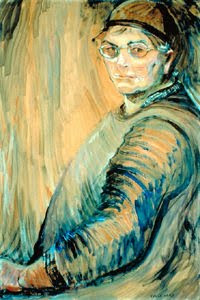It goes to say that the blog isn't making any statement of endorsement for any political party, and that the research within is not taking from an examination of Party policies. It has been extracted from online media research.
It reminds me of the time many years ago when the mayor of a small Ontario town received a letter from the provincial government asking what was the state of the arts in his community. The Mayor wrote; "Well Art Bolton is doing ok except for a little arthritis in his hip. And, I talked to Art Jones the other day and he looked pretty good for an old fellow. But, poor old Art Thomas has been struggling with his gout and that has made his life miserable."

As far as an artstic nature goes, the Globe and Mail writes about Jack Layton.
He is more than a fair musician. Not only does he play guitar, he surprised journalists this week with an impromptu rendition of Hit the Road Jack on a grand piano in the lobby of a hotel in Saint John, N.B.
But more importantly for Canada's artists;
The NDP will permit income-averaging for artists so they can spread out their often erratic earnings over a period of years. And, Give $20,000 annual federal tax exemption for artists' income earned from royalties.
And force the Canadian Radio-television Telecommunications Commission to ensure prime time TV in both English and French is Canadian.
Looks Good Jack. Looks Good.
Source: Toronto Star http://www.thestar.com/FederalElection/article/504199
Hmmm: Stephen Harper called Arts and Culture a "Niche Issue." But to be fair, this was said in the 2008 election. That aside, Stephen is noted for his cut to arts funding, when he served as Prime Minister.
http://www.friends.ca/news-item/7290
http://www.thestar.com/FederalElection/article/504811
Michae; Ignatieff has been pretty consistent about the importance of funding the arts.
“Arts and culture is central to the identity of Canada and Quebec, which is why Liberals believe the federal government has an important role to play in promoting our artists,” said Mr. Ignatieff.
Taken from http://www.musicpublishercanada.ca/2011/04/22/michael-ignatieff-announces-new-support-for-canadian-artists/ The Canadian Music Publisher's site.
http://www.musicpublishercanada.ca/2011/04/22/michael-ignatieff-announces-new-support-for-canadian-artists/
Well about all I could find on Elizabeth May's stand on the arts came from a quote in a Canadian Press article:
"She (Elizabeth) rattled off a list of what she called orphan issues that were not touched on in Tuesday's debate, including homelessness, mental health, prescription drug costs, arts funding, women's equality and the treatment of Canadian military veterans."
http://www.google.com/hostednews/canadianpress/article/ALeqM5gH5sis1huXi36PR1ukwjU0UcjX_A?docId=6548556
Respectfully, what could comment could Gilles make about the national arts funding, since he is a separatist?
Open Parliament.com, reports:
"Mr. Speaker, on Monday, the Minister of Canadian Heritage and Official Languages could not say enough about the Canada Prizes for the Arts and Creativity, stating, and I quote: “This is a great project that will help unify our country.” On Tuesday, when questioned in the House about what he had said, the heritage minister denied having made the statement and even had a new version for us."
I am sure the Minister of Canadian Heritage and Official Languages tells us the truth one time in two. The question is when he told the truth. Did he tell the truth on Monday or on Tuesday?
http://openparliament.ca/hansards/485/29/only/
My apologies to Portrait readers for not providing 'clickable links'.






